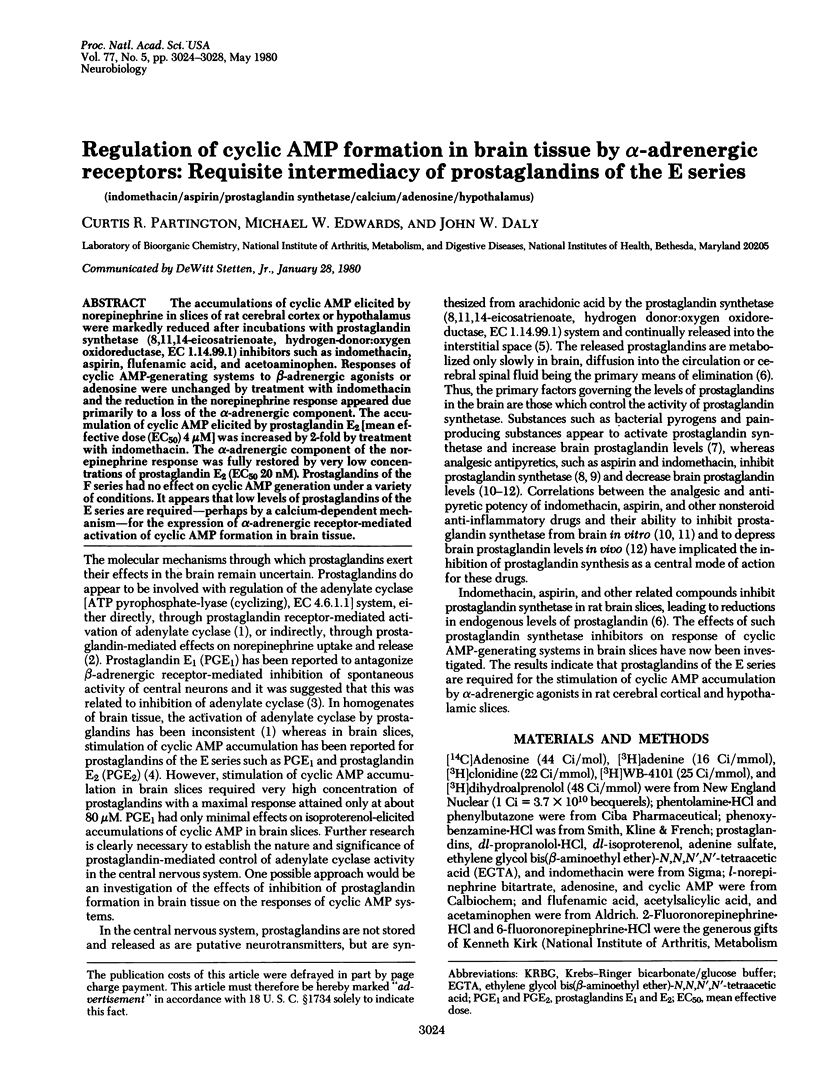Abstract
The accumulations of cyclic AMP elicited by norepinephrine in slices of rat cerebral cortex or hypothalamus were markedly reduced after incubations with prostaglandin synthetase (8,11,14-eicosatrienoate, hydrogen-donor:oxygen oxidoreductase, EC 1.14.99.1) inhibitors such as indomethacin, aspirin, flufenamic acid, and acetoaminophen. Responses of cyclic AMP-generating systems to beta-adrenergic agonists or adenosine were unchanged by treatment with indomethacin and the reduction in the norepinephrine response appeared due primarily to a loss of the alpha-adrenergic component. The accumulation of cyclic AMP elicited by prostaglandin E2 [mean effective dose (EC50) 4 micro M] was increased by 2-fold by treatment with indomethacin. The alpha-adrenergic component of the norepinephrine response was fully restored by very low concentrations of prostaglandin E2 (EC50 20 nM). Prostaglandins of the F series had no effect on cyclic AMP generation under a variety of conditions. It appears that low levels of prostaglandins of the E series are required--perhaps by a calcium-dependent mechanism--for the expression of alpha-adrenergic receptor-mediated activation of cyclic AMP formation in brain tissue.
Full text
PDF




Selected References
These references are in PubMed. This may not be the complete list of references from this article.
- Bergström S., Farnebo L. O., Fuxe K. Effect of prostaglandin E 2 on central and peripheral catecholamine neurons. Eur J Pharmacol. 1973 Mar;21(3):362–368. doi: 10.1016/0014-2999(73)90139-8. [DOI] [PubMed] [Google Scholar]
- Bylund D. B., Snyder S. H. Beta adrenergic receptor binding in membrane preparations from mammalian brain. Mol Pharmacol. 1976 Jul;12(4):568–580. [PubMed] [Google Scholar]
- Cantacuzene D., Kirk K. L., McCulloh D. H., Creveling C. R. Effect of fluorine substitution on the agonist specificity of norepinephrine. Science. 1979 Jun 15;204(4398):1217–1219. doi: 10.1126/science.221978. [DOI] [PubMed] [Google Scholar]
- Ciosek C. P., Jr, Ortel R. W., Thanassi N. M., Newcombe D. S. Indomethacin potentiates PGE1 stimulated cyclic AMP accumulation in human synoviocytes. Nature. 1974 Sep 13;251(5471):148–150. doi: 10.1038/251148a0. [DOI] [PubMed] [Google Scholar]
- Coceani F. Prostaglandins and the central nervous system. Arch Intern Med. 1974 Jan;133(1):119–129. [PubMed] [Google Scholar]
- Daly J. W., Padgett W., Nimitkitpaisan Y., Creveling C. R., Cantacuzene D., Kirk K. L. Fluoronorepinephrines: specific agonists for the activation of alpha and beta adrenergic-sensitive cyclic AMP-generating systems in brain slices. J Pharmacol Exp Ther. 1980 Mar;212(3):382–389. [PubMed] [Google Scholar]
- Daly J. W. The formation, degradation, and function of cyclic nucleotides in the nervous system. Int Rev Neurobiol. 1977;20:105–168. doi: 10.1016/s0074-7742(08)60652-2. [DOI] [PubMed] [Google Scholar]
- Dismukes K., Daly J. W. Accumulation of adenosine 3',5'-monophosphate in rat brain slices: effects of prostaglandins. Life Sci. 1975 Jul 15;17(2):199–209. doi: 10.1016/0024-3205(75)90504-4. [DOI] [PubMed] [Google Scholar]
- Feldberg W., Gupta K. P., Milton A. S., Wendlandt S. Effect of pyrogen and antipyretics on prostaglandin acitvity in cisternal c.s.f. of unanaesthetized cats. J Physiol. 1973 Oct;234(2):279–303. doi: 10.1113/jphysiol.1973.sp010346. [DOI] [PMC free article] [PubMed] [Google Scholar]
- Ferreira S. H., Moncada S., Vane J. R. Indomethacin and aspirin abolish prostaglandin release from the spleen. Nat New Biol. 1971 Jun 23;231(25):237–239. doi: 10.1038/newbio231237a0. [DOI] [PubMed] [Google Scholar]
- Flower R. J., Vane J. R. Inhibition of prostaglandin synthetase in brain explains the anti-pyretic activity of paracetamol (4-acetamidophenol). Nature. 1972 Dec 15;240(5381):410–411. doi: 10.1038/240410a0. [DOI] [PubMed] [Google Scholar]
- Gilman A. G., Nirenberg M. Regulation of adenosine 3',5'-cyclic monophosphate metabolism in cultured neuroblastoma cells. Nature. 1971 Dec 10;234(5328):356–358. doi: 10.1038/234356a0. [DOI] [PubMed] [Google Scholar]
- Hamprecht B., Schultz J. Influence of noradrenalin, prostaglandin E1 and inhibitors of phosphodiesterase activity on levels of the cyclic adenosine 3':5'-monophosphate in somatic cell hybrids. Hoppe Seylers Z Physiol Chem. 1973 Dec;354(12):1633–1641. doi: 10.1515/bchm2.1973.354.2.1633. [DOI] [PubMed] [Google Scholar]
- Hoffer B. J., Siggins G. R., Bloom F. E. Prostaglandins E1 and E2 antagonize norepinephrine effects on cerebellar purkinje cells: microelectrophoretic study. Science. 1969 Dec 12;166(3911):1418–1420. doi: 10.1126/science.166.3911.1418. [DOI] [PubMed] [Google Scholar]
- Negro-Vilar A., Ojeda S. R., McCann S. M. Catecholaminergic modulation of luteinizing hormone-releasing hormone release by median eminence terminals in vitro. Endocrinology. 1979 Jun;104(6):1749–1757. doi: 10.1210/endo-104-6-1749. [DOI] [PubMed] [Google Scholar]
- Ohga Y., Daly J. W. The accumulation of cyclic AMP and cyclic GMP in guinea pig brain slices. Effect of calcium ions, norepinephrine and adenosine. Biochim Biophys Acta. 1977 Jun 23;498(1):46–60. doi: 10.1016/0304-4165(77)90086-1. [DOI] [PubMed] [Google Scholar]
- Ojeda S. R., Negro-Vilar A., McCann S. M. Release of prostaglandin Es by hypothalamic tissue: evidence for their involvement in catecholamine-induced luteinizing hormone-releasing hormone release. Endocrinology. 1979 Mar;104(3):617–624. doi: 10.1210/endo-104-3-617. [DOI] [PubMed] [Google Scholar]
- Salomon Y., Londos C., Rodbell M. A highly sensitive adenylate cyclase assay. Anal Biochem. 1974 Apr;58(2):541–548. doi: 10.1016/0003-2697(74)90222-x. [DOI] [PubMed] [Google Scholar]
- Schwabe U., Daly J. W. The role of calcium ions in accumulation of cyclic adenosine monophosphate elicited by alpha and beta adrenergic agonists in rat brain slices. J Pharmacol Exp Ther. 1977 Jul;202(1):134–143. [PubMed] [Google Scholar]
- U'Prichard D. C., Greenberg D. A., Snyder S. H. Binding characteristics of a radiolabeled agonist and antagonist at central nervous system alpha noradrenergic receptors. Mol Pharmacol. 1977 May;13(3):454–473. [PubMed] [Google Scholar]
- Vane J. R. Inhibition of prostaglandin synthesis as a mechanism of action for aspirin-like drugs. Nat New Biol. 1971 Jun 23;231(25):232–235. doi: 10.1038/newbio231232a0. [DOI] [PubMed] [Google Scholar]
- Weinryb I., Chasin M., Free C. A., Harris D. N., Goldenberg H., Michel I. M., Paik V. S., Phillips M., Samaniego S., Hess S. M. Effects of therapeutic agents on cyclic AMP metabolism in vitro. J Pharm Sci. 1972 Oct;61(10):1556–1567. doi: 10.1002/jps.2600611003. [DOI] [PubMed] [Google Scholar]
- Wolfe L. S., Rostworowski K., Pappius H. M. The endogenous biosynthesis of prostaglandins by brain tissue in vitro. Can J Biochem. 1976 Jul;54(7):629–640. doi: 10.1139/o76-092. [DOI] [PubMed] [Google Scholar]
- Zanella J., Jr, Rall T. W. Evaluation of electrical pulses and elevated levels of potassium ions as stimulants of adenosine 3', 5'-monophosphate (cyclic AMP) accumulation in guinea-pig brain. J Pharmacol Exp Ther. 1973 Aug;186(2):241–252. [PubMed] [Google Scholar]


